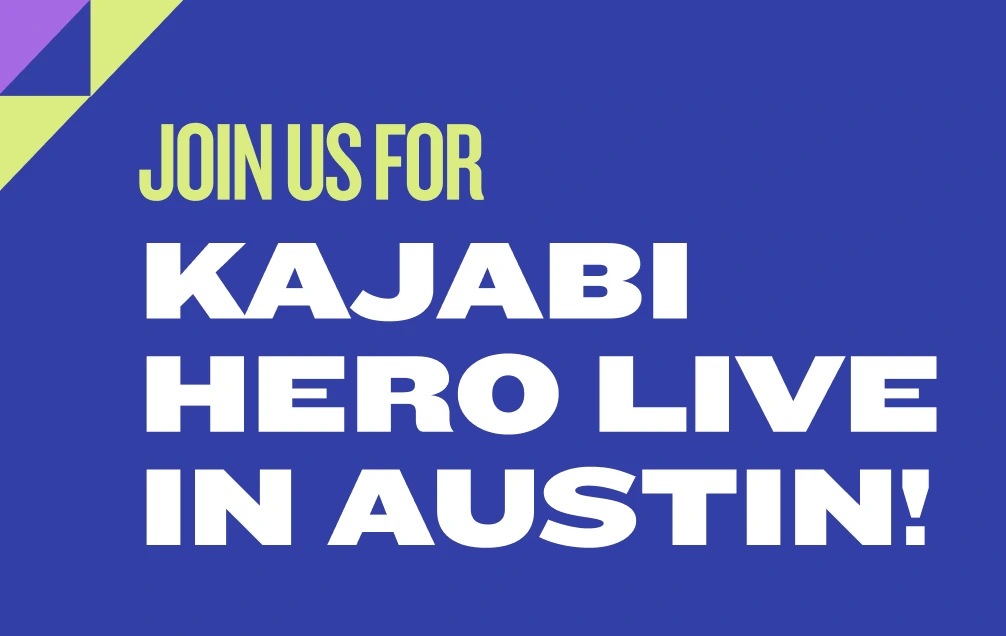
5 ways to use Facebook to sell more courses
Get free expert insights and tips to grow your knowledge business sent right to your inbox.
With billions of daily users whom you can friend and add to your audience for free, it’s no wonder that Facebook has become a modern gold rush for online course creators and marketers.
If you're curious as to how you can use Facebook to build your audience, grow your authority and sell more courses, you are in the right place!
In this article, we’ll look at why you should be using Facebook to sell your Kajabi course, as you learn 5 different ways to market your course on Facebook.
Let’s get started!
9 reasons you should be using Facebook to sell your online courses
- Facebook is the 3rd most popular website in the entire world trailing only Google and Youtube. Just Google and Youtube get more visitors than Facebook and advertising on both of those sites is way more expensive and has a much lower return on ad spend.
- Facebook’s revenue per user has TRIPLED since 2015. In just 3 short years, the revenue per Facebook user has tripled that means every Facebook user is spending almost 100% more money on Facebook every year over the last 3 years.
- 68% of all American’s use Facebook. That means 2 out of every 3 Americans use Facebook. That’s roughly 195 million people using Facebook in the US alone.
- 66% of all Facebook users use it daily. And of those 195 million Americans about 117 million of them use the platform every day.
- Americans spend an average of 58 minutes a day online with each visit lasting roughly 10-12 minutes. Those 117 million Americans, they spend almost an hour on Facebook daily making between 4-5 trips to the platform each day.
- 200 million people are members of Facebook groups. That’s 200 million people that you can target based on their interests in groups like “Course Creators” or “ Self-Improvement.”
- 78% of American consumers have discovered and bought a product on Facebook. Almost 80 % of all Facebook users have found a product on Facebook and either bought it right then and there or purchased it later. That’s about 93 million people who have discovered and purchased a product because of Facebook.
- The average Facebook user clicks on 8 ads per month. That’s 936 million clicks per month on Facebook just in the United States alone.
- E-commerce rates have tripled since 2015. In the last 3 years, three times as much money is being spent on e-commerce through Facebook.
Now let’s look at how you can use Facebook to sell more courses!
5 Ways to Use Facebook to sell more courses
1. Facebook advertising:
The most obvious but most challenging way to make money on Facebook is through Facebook ads. Before using Facebook ads to sell your Kajabi course, you want to make sure that you have an excellent feel for your audience.
You’ll want to create a customer persona consisting of things like demographic information, language used, and the big problems your ideal customer is having. You can then use Facebook’s granular targeting to create particular audiences based on interests, demographic information, and habits. Once you have a good handle on your customer persona, you will want to start building a few different types of ads.
At the very least, you will want to create an image ad and a video ad to see what your audience responds to. You should also create 3-5 different versions of your image ads to split test with Facebook’s new split test feature. Experiment with sending people who click on your ads directly to a sales page vs. sending them to the first step of a sales funnel, getting the email address and nurturing them before trying to make the sale.
The secret to all Facebook marketing is testing and tracking. Start your Facebook advertising with a 7-day test. To get enough impressions and clicks to tell which of your ads is performing the best, you will want to set a budget of at least $100 a day. After 7 days of running ads, review all the information and look for your click-through rate, conversion rate and your return on ad spend.
Here are some excellent general benchmarks for a successful Facebook advertising campaign;The average conversion rate for a Facebook ad is about 9.21%, the average click-through rate for an ad is about .90 %, and the average cost per click is $1.72. If the numbers from your campaign are dramatically lower than those, you will want to pause your ads and try again or consider hiring a Facebook ad professional to assist you.
2. Facebook groups:
There are over 200 million people in Facebook groups. That’s 200 million people who have decided to put their hands up and let you know that they are interested in a specific subject. There are 2 ways to use Facebook groups depending on whether you have created the group yourself or the group is someone else’s.
The 2 Types of Facebook Groups:
- Other People’s Groups (OPG). The way to use other people’s groups to sell your course is straightforward; treat the group like your email list and drip them your best content. The first step to using other people’s groups is to select groups that let their members post content every day. Most people who create a Facebook group have done so to sell their product or services. You don’t want to join this kind of groups because they tend to be very restrictive of who can post what when. Instead, you want to find groups that are more generalized. For instance, if you teach a course on Dog Training, instead of joining a group for dog training coaches, you would enter a group on the subject of dog training. When you join OPG’s, they will often have a set of rules you have to agree to join the group. If you see that you have to agree not to post content or videos that is not the group for you. Instead, you’ll want to join groups that allow people to post non-spam content. After you join, start dripping your content, and then this is KEY; participate in the community. If you just drip your content out there, people are going to figure out that you’re not really a part of the community. However, if you also answer questions, post questions and take part in general discussion while dripping your content, that is a recipe for success.
- Your own Facebook group. You should have your own Facebook group. The first thing you need to do is figure out if you want to make it free or paid. If you're going to make it free, then you’ll want to title it something broad and generic that could double as a search term like “Local Business Consulting” or “ Dog Agility Training.” With a free group you want to get as many members as possible and prompt as many discussions as you can by posting questions, videos, doing live chats, etc. The first step with either a paid group or a free group is to make it valuable and build a community around it. You do this by spending time there or hiring someone to spend time there. Don’t let questions go unanswered, give good applicable advice and let other people add value as well. Once the free group is valuable, you can begin to nurture them to buy your product with opt-in opportunities like a sticky post with your offer and monthly webinars or offers. If you decide to have a paid Facebook group, you want to make the group name a specific goal like “ Get your first local consulting client in 90 days or less.” or “ Get your dog competing in agility shows in 30 days!” These paid groups are going to function like short-term coaching programs. You are going to create a specific coaching offer that goes with the group. To use our 90 days to a consulting client example, you would create content (or re-purpose it from your course) and deliver it in the group in exchange for a monthly fee. Paid groups are a great way to start making money on Facebook and add a second offer to your original Kajabi course.

3. Facebook Lives: Recently Susan Garret, the creator of the 3 biggest FB lives of all time, gave a private speech where she shared some insights on using FB live. 2 things were exciting. The first was that the best time to do a Facebook live is on Sunday mornings at around 10 am eastern standard time because that is when Facebook has the least amount of staff on hand to throttle down your organic reach. The second thing she said was that she was getting twice as many views on Facebook live as she was when she used more produced previously recorded videos. Facebook is very invested in the success of live videos and is encouraging users to go live more and more. But how do you use Facebook lives to sell more courses?

Let’s start with the setup.
You need to download and use the Facebook creators app and use that rather than using your regular Facebook app. Don’t ask why, but the Facebook algorithm prefers that app.
You can use your phone to stream a live, but if you’re going to do that, you’ll want to at least get a rig set up like this one to stabilize your phone and provide a better microphone. If you want to use your regular video camera to record live on Facebook, you can do that using this Black Magic Mini-Recorder Thunderbolt with almost any camera.
To go up another level of production, you can get the Mevo Plus which allows you to stream in 4k as well as use multiple camera angles you can control from your phone.
Have you ever seen one of those live videos that seem incredibly well produced with images, texts, and effects? Well, there’s an app for that. It even provides a teleprompter on your phone.
Once you have your live setup ready you will want to start going live on a regular basis.
There are 3 kinds of FB live content you should create to sell more courses:
- Interviews. The most natural kind of live content to create is to host an interview with either a student who took your courses and is having great success or another expert.
- Masterclasses. In a masterclass, you take 30-90 minutes to teach a specific topic like “How to contact potential consulting clients” which should be related to your main course then offer a discount on your course at the end.
- Social Proof. With social proof lives you show your audience all the cool things you are doing whether it’s meeting with a Fortune 500 company or going to a concert.
4. Messaging people. Studies have found that people are 3.5 times more likely to open a Facebook message than an email. One of the simplest ways to sell more courses on Facebook is by simply manually messaging anyone who comments or likes any post related to your course. While this is time-consuming in our last point, you will learn a way to automate it once you have a feel for your general sales sequence.

Here’s how to message people on Facebook without spamming or being sales-y.
After you post a piece of content related to your course and people like and comment on the post you will want to message, them saying something like “Hey thanks for the great comment glad you liked my post! What do you have going on these days?”
Almost everyone will respond to this type of message with a brief explanation of what they are working on or why they liked or commented on the post.
You will want to offer advice or ask questions about what their big challenge is related to your course.
This is very important don’t skip straight to pitching your course!
After a few messages you might say something like “ I think my course would really help you, would you be interested in joining today if I gave you a discount ?”
Then offer them a discount of between 25-50% if they buy now.
While manually messaging people is time-consuming and can be frustrating, you will make sales if you do this every time you post content.
5. Chatbots. Hopefully, you have been convinced of the power of selling over Facebook messenger manually. If there was an affordable solution to automating that process, would it be something you were interested in? Enter chatbots. A chatbot is a piece of software that uses Artificial Intelligence to have simple conversations with people online. Check out this video to learn more about how chatbots work. One of the places chatbots are getting used most frequently is on Facebook. Chatbots allow you to automate talking to potential clients on Facebook messenger. Facebook is encouraging advertisers to create bots with pre-planned chat flows which can do everything from encouraging readers to subscribe to your blog to making sales. Chatbots do vary in quality so you will want to do your research but some of the more reputable companies include Manychat and Conversible. To learn more about using chatbots on Facebook check out this Hootsuite article.
There you have it 5 ways to sell more courses on Facebook!
The next step is to pick 1-2 of these strategies and start implementing them. Once you get those strategies down, add a few more until you are using all 5 strategies in this article to turn Facebook into your own personal ATM!
Use Kajabi to turn your knowledge into products you can sell on Facebook
We know that you have something to teach the world. We also know there are people out there who want to learn what you know. That’s why we created Kajabi. It’s a full-featured platform that allows professionals like you to create their own businesses from home.
Create online courses, establish membership sites, and sell other digital products. We offer tons of marketing tools to help you spread the word about your products and earn more revenue. You can then use the tips here to better sell those courses on Facebook.













